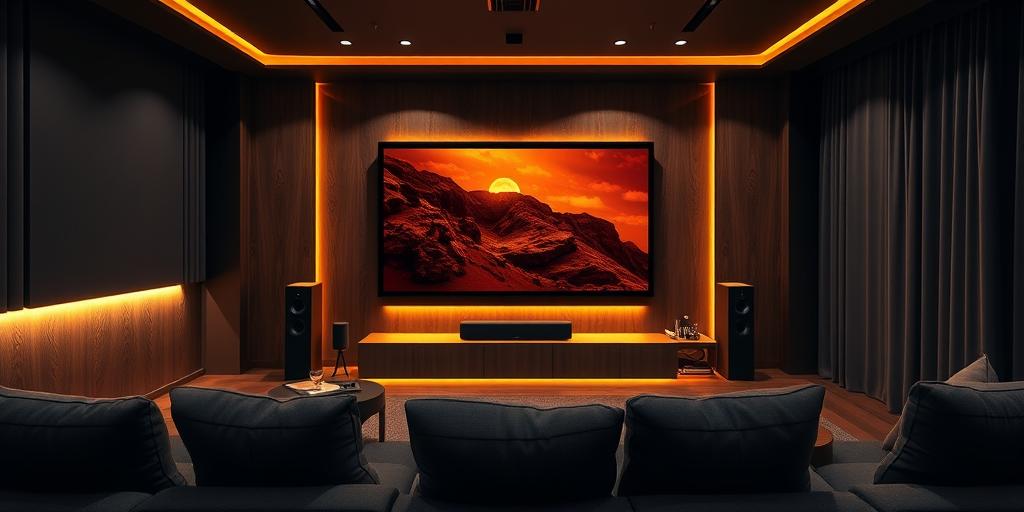Are you ready to transform your living room into a cinematic paradise? Setting up a home entertainment system might seem daunting, but with our guide, it’s easier than you think! We’ll walk you through every step, from selecting the right components to optimizing the sound and picture quality. Get ready to immerse yourself in the ultimate home theater experience. You’ll be amazed at how simple it is to create the ultimate entertainment setup.
Choosing Your Core Components: The Heart of Your Home Entertainment System
The foundation of any great home entertainment system rests on a few key components. Selecting the right ones is crucial for achieving optimal performance. Let’s delve into the essentials:
The Display: Choosing the Right TV or Projector
The star of your home theater is undoubtedly the display. Today, you have a fantastic range of choices, from stunning 4K TVs offering vibrant colors and breathtaking clarity to impressive projectors that create an immersive cinema-like experience. Consider your budget, room size, and desired viewing experience when making your selection. For a truly immersive experience, look into features like HDR (High Dynamic Range) for increased contrast and color depth and local dimming for deeper blacks.
The Sound System: Elevating Your Audio Experience
While a fantastic picture is essential, the sound is what truly completes the experience. Consider your budget and space when choosing a sound system. A simple soundbar can offer a significant upgrade to your TV’s built-in speakers. For a more sophisticated setup, a 5.1 or 7.1 surround sound system provides an enveloping soundscape that will truly transport you into the movie. To get that perfect sound, look for receivers with Dolby Atmos or DTS:X support for object-based audio to make your home theater sound amazing.
The Source: Streaming, Blu-ray, or Both?
How will you get content to your display? Streaming services like Netflix, Hulu, and Disney+ offer a vast library of movies and shows on demand. A Blu-ray player provides a high-quality alternative for physical media. Consider how you prefer to consume media to determine which option is best for you. You can also make use of a media player or gaming console to connect to your home entertainment system.
Connecting Your Components: Creating the Perfect Setup
Once you have your core components, it’s time to connect them correctly. This involves connecting the HDMI cables to your TV, receiver, Blu-ray player, streaming device, and gaming console. Each of the components connects together to form a solid network, and the HDMI connection is used to provide optimal performance. Ensuring all the HDMI connections are firmly secured prevents problems during use, which can be frustrating and make the system harder to use. Make sure you refer to the manuals for each device to make sure the connections are right.
HDMI Cable Considerations
Using high-quality HDMI cables is essential for optimal picture and sound quality. Low-quality cables can lead to signal loss, resulting in a blurry image or audio dropouts. Investing in quality cables is crucial.
Cable Management: Keeping it Tidy
Once everything’s connected, use cable ties or a cable management system to keep your setup organized. This not only looks better but also helps to prevent tangles and accidental disconnections.
Optimizing Your Home Entertainment System for the Best Performance
Getting the best from your home entertainment system isn’t just about connecting the components. Optimizing the settings is just as important. These crucial steps will help enhance your experience.
Picture Settings: Fine-tuning for Optimal Visuals
Experiment with different picture settings to find what works best for your TV and room. You might want to adjust the brightness, contrast, sharpness, and color settings to achieve a more natural and realistic image.
Sound Settings: Tweaking for Immersive Audio
Similar to picture settings, play around with your audio settings. Experiment with different sound modes, adjust the bass and treble, and use a sound calibration tool to optimize the audio for your room. Make sure you adjust your audio settings to perfectly match your video settings.
Room Acoustics: Enhancing the Soundstage
Room acoustics can have a significant impact on sound quality. Consider adding some sound-absorbing materials like rugs or curtains to reduce reflections and create a clearer soundscape. The placement of your speakers also plays an important part in getting the best surround sound experience in your home.
Taking Your Home Entertainment Setup Further
Once you have the essentials in place, there are many ways to expand your home theater. Consider adding a subwoofer to enhance the bass response, or smart home integration for convenient control.
Ready to build your dream home entertainment system? Start today by picking the components to fit your budget and space and soon, you’ll be enjoying the ultimate home theater experience!




